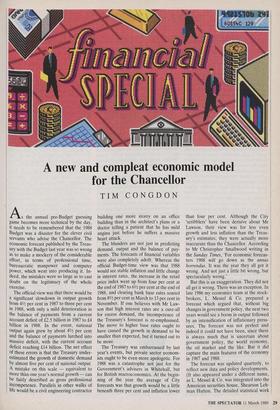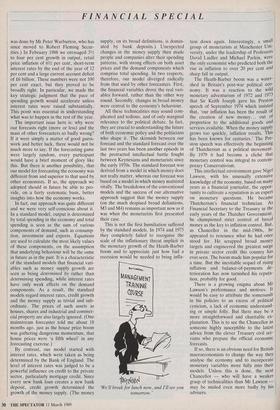A new and compleat economic model for the Chancellor
TIM CONGDON
As the annual pre-Budget guessing game becomes more technical by the day, it needs to be remembered that the 1988 Budget was a disaster for the clever civil servants who advise the Chancellor. The economic forecast published by the Treas- ury with the Budget last year was so wrong as to make a mockery of the considerable effort, in terms of professional time, bureaucratic manpower and computer Power, which went into producing it. In- deed, the mistakes were so large as to cast doubt on the legitimacy of the whole exercise.
The official view was that there would be a significant slowdown in output growth from 41/2 per cent in 1987 to three per cent in 1988, with only a mild deterioration in the balance of payments from a current account deficit of £2.5 billion in 1987 to £4 billion in 1988. In the event, national output again grew by about 41/2 per cent and the balance of payments lurched into massive deficit, with the current account deficit reaching £14 billion. The net effect of these errors is that the Treasury under- estimated the growth of domestic demand by almost five per cent of national output. A mistake on this scale — equivalent to more than one year's normal growth — can be fairly described as gross professional incompetence. Parallels in other walks of life would be a civil engineering contractor building one more storey on an office building than in the architect's plans or a doctor telling a patient that he has mild angina just before he suffers a massive heart attack.
The blunders are not just in predicting demand, output and the balance of pay- ments. The forecasts of financial variables were also completely adrift. Whereas the official Budget-time view was that 1988 would see stable inflation and little change in interest rates, the increase in the retail price index went up from four per cent at the end of 1987 to 61/2 per cent at the end of 1988, and clearing bank base rates soared from 81/2 per cent in March to 13 per cent in November. If one believes with Mr Law- son that high interest rates are a cure-all for excess demand, the incompetence of the Treasury's forecast is re-emphasised. The move to higher base rates ought to have caused the growth in demand to be smaller than expected, but it turned out to be more.
The Treasury was embarrassed by last year's events, but private sector econom- ists ought to be even more apologetic. For 1988 was a catastrophe not just for the Government's advisers in Whitehall, but for British macroeconomics. At the begin- ning of the year the average of City forecasts was that growth would be a little beneath three per cent and inflation lower
than four per cent. Although the City 'scribblers' have been derisive about Mr Lawson, their view was for less even growth and less inflation than the Treas- ury's estimates; they were actually more inaccurate than the Chancellor. According to Mr Christopher Smallwood writing in the Sunday Times, 'For economic forecas- ters 1988 will go down as the annus horrendus. It was the year they all got it wrong. And not just a little bit wrong, but spectacularly wrong.'
But this is an exaggeration. They did not all get it wrong. There was an exception. In late 1986 my economics team at the stock- brokers, L. Messel & Co. prepared a forecast which argued that, without big changes in government policy, the next two years would see a boom in output followed by an intensification of inflationary press- ures. The forecast was not perfect and indeed it could not have been, since there is always much that is uncertain about government policy, the world economy, the oil market and the like. But it did capture the main features of the economy in 1987 and 1988.
The forecast was updated quarterly, to reflect new data and policy developments. (It also appeared under a different name, as L. Messel & Co. was integrated into the American securities house, Shearson Leh- man Hutton. The detailed statistical work
FINANCIAL SPECIAL
was done by Mr Peter Warburton, who has since moved to Robert Fleming Secur- ities.) In February 1988 we envisaged 31/2 to four per cent growth in output, retail price inflation of 61/2 per cent, short-term interest rates by the end of the year of 12 per cent and a large current account deficit of £6 billion. These numbers were not 100 per cent exact, but they proved to be broadly right. In particular, we made the key strategic judgment that the pace of spending growth would accelerate unless interest rates were raised substantially. This point was essential in understanding what was to happen in the rest of the year.
The important issue here is: why were our forecasts right (more or less) and the mass of other forecasters so badly wrong? If it were simply a matter of good guess- work and better luck, there would not be much more to say. If the forecasting game were largely random, every participant would have a brief moment of glory like this. But there is another possibility, that our model for forecasting the economy was different from and superior to that used by other economists. If so, the approach we adopted should in future be able to pro- vide, on a fairly systematic basis, better insights into how the economy works.
In fact, our approach was quite different and we were very self-conscious about it. In a standard model, output is determined by total spending in the economy and total spending is seen as the sum of various components of demand, such as consump- tion, investment and exports. Equations are used to calculate the most likely values of these components, on the assumption that underlying behaviour will be the same in future as in the past. It is a characteristic of the standard models that financial vari- ables such as money supply growth are seen as being determined by rather than determining spending, while interest rates have only weak effects on the demand components. As a result, the standard models regard interest rates, credit growth and the money supply as trivial and sub- ordinate. The prices of such assets as houses, shares and industrial and commer- cial property are also largely ignored. (One mainstream forecaster told me about 18 months ago, just as the house price boom was gathering dangerous momentum, that house prices were 'a fifth wheel' in any forecasting exercise.)
By contrast, our model started with interest rates, which were taken as being determined by the Bank of England. The level of interest rates was judged to be a powerful influence on credit to the private sector, particularly mortgage credit. Since every new bank loan creates a new bank deposit, credit growth determined the growth of the money supply. (The money supply, on its broad definitions, is domin- ated by bank deposits.) Unexpected changes in the money supply then made people and companies alter their spending patterns, with strong effects on both asset prices and the demand components which comprise total spending. In two respects, therefore, our model diverged radically from that used by other forecasters. First, the financial variables drove the real vari- ables forward, rather than the other way round. Secondly, changes in broad money were central to the economy's behaviour.
All these technicalities may sound com- plicated and tedious, and of only marginal relevance to the political debate. In fact, they are crucial to understanding the future of both economic policy and the politicians who shape it. The skirmish between our forecast and the standard forecast over the last two years has been another episode in the protracted intellectual battle fought between Keynesians and monetarists since the early 1970s. The standard forecast was derived from a model in which money does not really matter, whereas our forecast was based on a model in which money mattered vitally. The breakdown of the conventional models and the success of our alternative approach suggest that the money supply (on the much despised broad definitions, M3 and M4) remains as important now as it was when the monetarists first presented their case.
This is not the first humiliation suffered by the standard models. In 1974 and 1975 they completely failed to recognise the scale of the inflationary threat implicit in the monetary growth of the Heath-Barber boom and to appreciate just how bad a recession would be needed to bring infla- 'We'll break for lunch now, and I'll see you tomorrow.' tion down again. Interestingly, a small group of monetarists at Manchester Um- versity, under the leadership of Professors David Laidler and Michael Parkin, were the only economist who predicted both the rise in inflation to over 20 per cent and sharp fall in output.
The Heath-Barber boom was a water- shed in Britain's post-war political eco- nomy. It was a reaction to the wild monetary adventurism of 1972 and 1973 that Sir Keith Joseph gave his Preston speech of September 1974 which insisted that, 'our inflation has been the result of the creation of new money... out of proportion to the additional goods and services available. When the money supplY grows too quickly, inflation results. This has been known for centuries.' The Pre- ston speech was effectively the beginning of Thatcherism as a political movement. By 1979 it had become a cliché that monetary control was integral to contem- porary Conservativism.
This intellectual environment gave Nigel Lawson, with his unusually extensive knowledge of the economy, based on many years as a financial journalist, the oppor- tunity to cultivate a reputation as an expert on monetary questions. He became Thatcherism's financial technician. As Financial Secretary to the Treasury in the early years of the Thatcher Government, he championed strict control of broad money as the key to inflation control. But, as Chancellor in the mid-1980s, he appeared to renounce what he had once stood for. He scrapped broad money targets and engineered the greatest surge in private sector credit this country has ever seen. The boom made him popular for a time. But the inevitable sequel of rising inflation and balance-of-payments de- terioration has now tarnished his reputa- tion, probably for good.
There is a growing enigma about Mr Lawson's performance and motives. It would be easy to attribute the somersault in his policies to an excess of political cynicism, a lack of economic understand- ing or simple folly. But there may be a more straightforward and charitable ex- planation. This is to see the Chancellor as someone highly susceptible to the latest advice from the clever Treasury civil ser- vants who prepare the official economic forecasts.
If so, there is an obvious need for British macroeconomists to change the way they analyse the economy and to incorporate monetary variables more fully into their models. Unless this is done, the next Chancellor — who will have a weaker grasp of technicalities than Mr Lawson — may be misled even more badly by his advisers.



























































 Previous page
Previous page